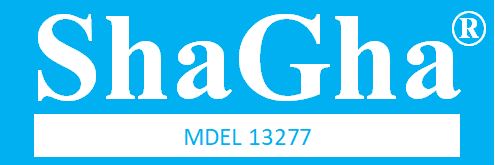Surgical Instruments
Surgical Instruments are specially designed instruments used by experts in the medical fraternity for performing specific actions during surgeries or operations. Over time, these tools and instruments have been consistently modified.
These surgical instruments are made by master craftsmen using the highest quality surgical steel. Every instrument is individually checked with maximum precision for perfect workmanship, pattern, and finish.
If you’re unable to locate a specific instrument on our website, please call us at: (905) 607-5554 and our service team will promptly help you find it at the right price. No matter the item's brand, type, or size, we can get it - even if back-ordered.
-
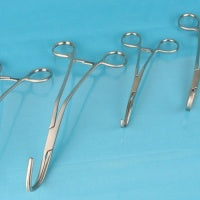
Clamps
Clamping and Occluding Instruments are used in many surgical procedures for compressing blood vessels or hollow organs, to prevent their contents from leaking. Occlude means to close or shut. Therefore, these instruments are also used to control bleeding. They are either straight, curved, or angled, and have a variety of inner jaw patterns. Some clamps are designed to crush the structure when applied. Others are non-crushing and are used to occlude or secure tissue.
-
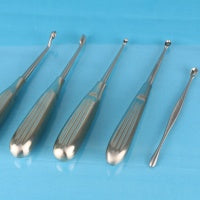
Curettes
A surgical instrument shaped like a scoop or spoon is used to remove tissue or growths from a body cavity. Although they are not typically cutting instruments they are used for minor cutting as well.
-
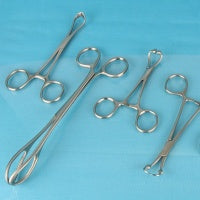
Forceps
Grasping and Holding Instruments - as their name suggests, are used to grasp and hold tissue, without injuring surrounding tissues or blood vessels that may be in the way during a surgical procedure. Forceps can be ringed or the thumbed variety. Hemostatic Ring forceps (aka hemostatic forceps) are hinged and look like ring scissors.
-
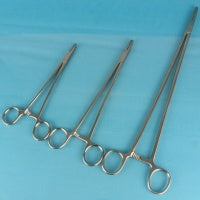
Needle Holders
Suturing Needle holder sizes vary according to the type of needle used. Most instrument sets will have Webster, Cricklewood, and Mayo Hegar-type needle holders. Clip appliers place individual staples, available in reusable and disposable.
-
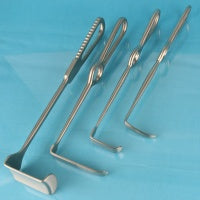
Retractors
Retracting and Exposing - instruments are used to hold back or retract organs and tissue so the surgeon has access to the operative area. They spread open the skin, ribs, and other tissue; and are also used to separate the edges of a surgical incision. Some retracting and exposing instruments are “self-retaining,” meaning they stay open on their own. Other manual styles need to be held open by hand. Used to pull Soft tissue and muscle aside to expose surgical site.
-
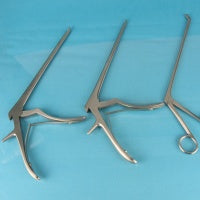
Rongeurs
A biting instrument used for cutting tough tissue or bone. A Rongeur is a strongly constructed instrument with a sharp-edged, scoop-shaped tip, used for gouging out bone. Rongeur is a French word that
means rodent or 'gnawer'. -
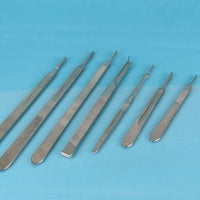
Scalpels
Used for initial incision and cutting tissue. Consists of a blade and a handle. Surgeons often refer to the instrument by its blade number. For example, #10 Blade is used primarily for making large skin incisions. #11. The blade is used for making precise or sharply angled incisions. The #15 Blade is a smaller version of the #10 blade used for making finer incisions.
-
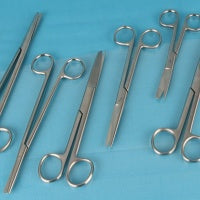
Scissors
Scissors with Straight Blades - cut in a straight line forward and the blades move (open and close the same plane the handles are pressed together. Scissors with Curved/Angled Blades - angled on the edge cut in the same plane in which the handles move but they are angled from the handle's axis (point up or down). Bandage/Utility Scissors - for cutting dressings, gauzes, tapes, bandages, dressing strips, metal, and metal/foam splints. The angled cutting blade and rounded blunt tip assist in the removal of dressings without harming the wound.
-
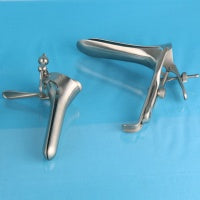
Speculum
Instruments for investigating body cavities with a form dependent on the body cavity for which it is designed. In old texts, the speculum may also be referred to as a diopter. A speculum is a broad-tipped instrument used to widen an opening or passage during the diagnosis or surgery. It may be used to widen the vagina to reach the cervix these are called Vaginal Specula.
